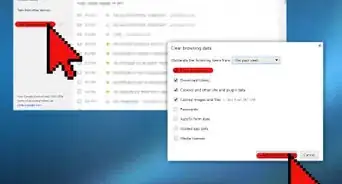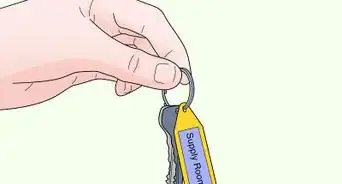This article was co-authored by Jennifer Landis-Santos, PCC, NBHWC. Jennifer Landis-Santos is a Certified Career Counselor & Wellness Coach and the Founder of Career Wellness, LLC. With 20 years of experience, she specializes in helping others identify and move towards a satisfying life and work balance. Jennifer is a graduate of Georgetown University’s Institute for Transformational Leadership, where she is on the faculty of the Health and Wellness Coaching Program. She's a Professional Certified Coach through the International Coach Federation and a Certified Career Counselor through the National Career Development Association.
wikiHow marks an article as reader-approved once it receives enough positive feedback. This article has 17 testimonials from our readers, earning it our reader-approved status.
This article has been viewed 614,559 times.
When are you leaving a position, it is likely that your manager or supervisor will ask you to help in the handover period to your successor. Being organised and proactive will help to ensure that your company has a smooth transition and you leave with an excellent professional reputation.
Steps
Organising Your Handover
-
1Discuss the handover with your manager. You should start by having a detailed discussion with your manager to determine exactly how they want you to handle the handover. Depending on your job and how your manager likes to work, you may be asked to contribute extensively to the handover. This could include the new person shadowing you for a few days or longer.
- In most instances you will have to at least prepare a formal handover document.
- Discuss this with your manager and find out how much you are expected to contribute, and what the focus of your handover should be.
-
2Draw up an early outline of your handover document. Once you have a clear idea of your manager’s expectations, you can start by drawing up a draft handover document. This will help you to organise yourself, and catalogue all the various tasks and pieces of information that you will need to pass on during the handover period. This document should include:
- Detailed information on your day-to-day activities, tasks and priorities.
- An outline of the key points of the role.
- A clear outline of what is expected of your successor.
- A list of any essential files that will be handed over. This might include a particular contract, or work programme.[1]
Advertisement -
3Tie up loose ends. If you know you will be leaving your post soon, it can be helpful to put in a little extra work to make sure that you tie up any loose ends. You will get a sense of satisfaction at achieving this, and you will also be helping your successor start off with a clean slate. Doing this will also help ensure that you leave on excellent terms and with a good reputation.[2]
- This won’t always be possible, but if you have something that is nearly over the line, put in a little extra work to get it done.
- A new person coming into a deal right when it is near the line may struggle to get it closed, because they are unfamiliar with all its intricacies.
- Let your manager and/or colleagues know what deliverables and milestones you will have completed before your last day.
-
4Communicate with your colleagues. Before your successor is due to start, try to make some time to talk to your colleagues about the handover and ask if there is anything your colleagues think you should highlight. If there is a developing issue that you are unaware of, this is a good opportunity to touch base and find out.
- Developing issues are not likely to affect your final days, but if you are aware of them then you can flag them up to your successor.
- This is also a chance to make sure everyone knows you’re leaving and when. Let your colleagues know about the handover period, so that they can take it into consideration.
- Your productivity is likely to slow during the handover, so its good practice to give your colleagues some advance warning.
-
5Write up a formal handover document. The final step of your handover preparation is to complete a formal handover document. You can build on the draft document, but try to elaborate and include all the important information. You will need to run through the document with your manager and any other key staff it will affect. Try to have this completed and sent to your successor at least a few days before they are set to start. The content will vary from job to job, but it may include some of the following:[3]
- A list and timetable of actions.
- A briefing of ongoing issues.
- A calendar of forthcoming events and deadlines.
- Passwords and login information.
- A list of useful contacts.
- A guide to navigating files and folders on the computer system.
Managing the Handover Period
-
1Allow as much time as possible. When your successor begins in the office, you may still be around and be asked to do a more complete handover. The length of this will vary, but in some instances you will be given a few days or longer to help the new person get to grips with the job. Generally the more time you have available for a full handover, the more information you will be able to pass on.
- There are bound to be things that you forgot about, and having someone shadow you is a good way to expose them to the variety of day-to-day activity.
-
2Hand over key documents personally. During the handover, it is good practice to ensure that all the key pieces of data and documentation and handed over personally. This will help you to make sure that the most important things are dealt with appropriately and priorities are clearly set out. Handing over documents face-to-face means that complex information can be discussed fully before you leave.
- This opportunity to explain key information, and for your successor to ask you direct questions is vital for a good handover.
- This will also give you an opportunity to provide nuance and context in a discussion that might have been overlooked otherwise.[4]
-
3Make the effort to help. If you are in the office with your successor, you should always be attentive and proactive. Make the effort to identify and help resolve any occurring issues. Your successor may be a little shy or intimidated in their first few days, and may not want to hassle you with questions.
- Make sure you make it clear that you are there to help, and you welcome queries.
- By doing this, you will be helping to foster a situation in which the responsibility for the handover is shared between you and your successor.[5]
-
4Have a final handover meeting. The last thing to do before you leave and complete the handover, is to do full handover meeting with your successor. Ask your successor to bring along any outstanding questions they have, and the notes they have made. This meeting is a great opportunity for the new person to ensure that they understand their role and responsibilities.
- Any uncertainties can be cleared up in the meeting.
- Depending on where you work, it might be prudent to invite your manager or supervisor to attend the meeting.
- You should certainly inform your manager of when and where it is taking place, and ask them if there is anything they would like to add.[6]
Thinking of Long-Term Development
-
1Highlight available support and training. Try to think of the handover as an opportunity for you to really contribute to giving someone the best possible chance to succeed. You are not just trying to hand off tasks and jobs, but are trying to help your successor’s professional development and your former employer’s long term-health.[7]
- Do this by pointing out any relevant training opportunities that you know of.
- Perhaps when you started the job, you received a suite of training to help you adapt and develop.
- Be sure you mention this to your successor, and encourage them to explore the possibilities.
-
2Don’t neglect the working culture. If you are spending time with the person who will be filling your position, it’s important not to focus solely on technical aspects of the job. Each place has a unique working environment and culture that can be intimidating or confusing for a newcomer. Be sure to set some time aside to give the new person the lowdown on how the office functions.
- Make the effort to take them around the office and introduce them to everyone.
- Be sure you clearly define the role of the new employee as well as existing employees.
- If the job description of the new arrival is slightly different to yours, or their responsibilities and priorities are focussed elsewhere, make sure existing staff recognise this.
-
3Provide your contact details. If you really want to go the extra mile, you could provide the new employee with your contact details. You might say that they can contact you if there is a major issue or they need a little guidance. Not everyone will be happy to do this, and it is likely to depend on your relationship with your former employer.
- Often a problem can be resolved with a simple email.
- Offering to help out after you leave will make a good impression and help boost your reputation.[8]
Community Q&A
-
QuestionWhat if I will not be meeting my successor? Are there things I should be mindful of?
 Community AnswerI'm in the same situation right now. I made a list of all ongoing processes and assigned people on my team to each, in discussion with my superior. In this case, the direct handover requires the focused involvement of other colleagues in all meetings and appointments. Written documentation should focus on processes that are complex and vulnerable to mistakes, rather than just status reports.
Community AnswerI'm in the same situation right now. I made a list of all ongoing processes and assigned people on my team to each, in discussion with my superior. In this case, the direct handover requires the focused involvement of other colleagues in all meetings and appointments. Written documentation should focus on processes that are complex and vulnerable to mistakes, rather than just status reports. -
QuestionDo I need a sample if I want to do a handover in an office?
 Community AnswerYes, it is helpful in getting you prepared for your handover.
Community AnswerYes, it is helpful in getting you prepared for your handover. -
QuestionHow do I send mail from person to person in an office?
 Community AnswerWrite a short note and have someone deliver it.
Community AnswerWrite a short note and have someone deliver it.
References
- ↑ http://www.generationy.com/importance-of-handover-document-notes/
- ↑ http://www.jobsite.co.uk/worklife/prepare-brilliant-holiday-handover-2-20033/
- ↑ https://bizfluent.com/how-6399370-write-handover-report.html
- ↑ https://www.gov.uk/government/uploads/system/uploads/attachment_data/file/216810/Preparing-for-Handover.pdf
- ↑ https://www.gov.uk/government/uploads/system/uploads/attachment_data/file/216810/Preparing-for-Handover.pdf
- ↑ http://www.generationy.com/importance-of-handover-document-notes/
- ↑ https://www.lynda.com/Business-Skills-tutorials/Preparing-handover/110278/123277-4.html
- ↑ http://www.generationy.com/importance-of-handover-document-notes/
About This Article
If you’re leaving your job and you need to do a handover to help train your successor, talk to your manager about what you’ll be expected to cover, and write a formal document detailing anything your successor will need to know. Have the new person shadow you for a few days and make sure they have everything they will need during the job. Before you leave, have a final handover meeting with your successor, giving them the opportunity to ask any questions they might have. For more information about writing your handover document, keep reading!








































































